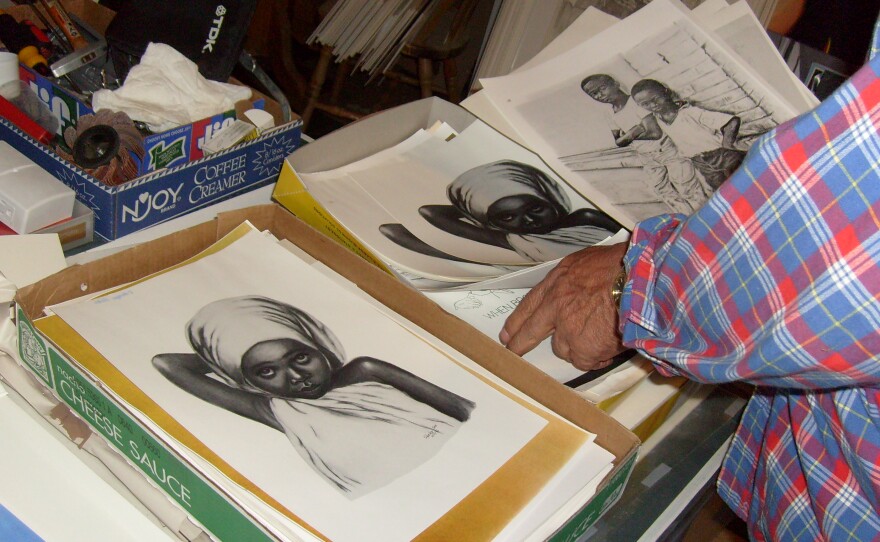Today is the beginning of our annual Project Milwaukee series. This week and next, we’re examining race relations in the city – how blacks and whites have interacted throughout history, and where those relationships stand today. This morning, we heard about the early history of race relations in Milwaukee – from before the Civil War to the end of World War II. Now, we hear from a man who’s part of that history. WUWM's Erin Toner reports.“My name is Sylvester Sims. I was born 1928 and I’ll be 81 this year.”
Sylvester Sims lives in a small home on Milwaukee’s far northwest side. When I walked in the door, music and the soft tick-tocking of two grandfather clocks filled his living room. And there were paintings everywhere, covering the walls, stacked along the hallway, and in boxes on the living room floor.
“I could always draw. I think I could draw before I knew my ABC’s,” Sims says.
But as a boy, Sims remembers white school teachers questioning his skills.
“They asked us to look in the book and draw something out of the book, and I drew it and teacher said, ‘You didn’t draw that.’ And they suspended me. You know, blacks weren’t supposed to know…only thing they taught us when we was going to school was Booker T. Washington and a few other blacks, but otherwise there was nothing mentioned. My mother came up and she raised all kind of hell. My mother asked them, ‘Have him draw it over for you.’ They were surprised,” Sims says.
Sims says growing up, his family moved around Milwaukee a lot, and he says they always had some white families as neighbors.
“When we lived on Winnebago, we had a mixture of families. We had Gypsies, we had Indians, a lot of Germans, a few Jewish people lived around in that area too. But we seemed to all got along pretty good, you know. The only difference when you go out of the neighborhood, like I was always interested in swimming, 16th and North, wasn’t too many blacks going to North Division at that time. The guys that run the swimming pool, they didn’t want us up there. They told us go back where we belong, in other words back to the 6th Ward,” Sims says.
The old 6th Ward was also called Bronzeville – known for its vibrant entertainment and business district, and tight-knit neighborhoods. In the 30s, Bronzeville was a six-block area on the city’s near north side.
“Back then when I was coming up, very seldom you locked your doors when you left the house. Didn’t nobody have nothing for you to take, really. Come in and eat your food. But outside of that they had a screen door with a nail bent to hold it closed,” Sims says.
Sims says back then, if you were black in Milwaukee, you didn’t harbor much hope of moving to another part of town – he says it was hell to try to buy a home. You didn’t even leave Bronzeville for long if you didn’t want to be harassed, say at a store or a church.
“St. Joseph’s used to be off of Galena. It was all-white parish. They really didn’t want us in there either. You could really see the way that people acted you know when you’d go to church there,” Sims says.
But there were great times. Sims says he remembers spending his childhood summers at city pools. They weren’t segregated, but he says blacks knew where they were welcome and where they weren’t. Sims says he’d be at the pool all day long, and taught himself to dive by reading a Red Cross book. At age 16, he entered the Amateur Athletic Union state diving meet.
“If I’m not mistaken I got straight 10s on everything that I did that day. You had to do a jackknife, you had to do a back dive, cutaway and front with a half twist,” Sims says.
Sims won the state title. A photo of his graceful swan dive was plastered across the front page of the newspaper.
“Major upset, they had it in the Sentinel. Sixteen-year-old colored boy, major upset,” Sims says.
That photo, in poster size, hangs in a small bedroom-turned-art-studio in Sims’ home. He lives alone these days, after losing his wife Betty eight years ago. They met at Bronzeville’s Regal Theater when he was an usher, and she was a popcorn girl.
Downstairs is where Sims does most of his work. In the basement, an easel holds an unfinished portrait of a little boy in a red shirt and floppy hat.
“I’m just making that up I was trying out some watercolor on the canvass, that’s a special canvass for watercolor, I was trying to make up something,” Sims says.
Sims says he loves painting people, especially children and the elderly. He’s also crafted pieces from his childhood memories and old photos of life in Bronzeville.
“My sister says I sit around too much and paint. I get up painting, go to bed painting,” Sims says.
He never had any art formal training, but says there were a few teachers who recognized his talent and encouraged it. That’s what Sims does now, by tutoring budding artists for free. He also donates a lot of his work to charity, and gives away canvasses and supplies to people who can’t afford them.

















